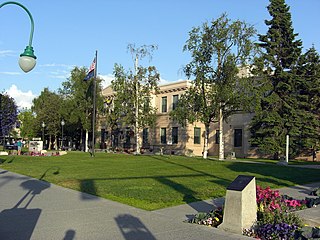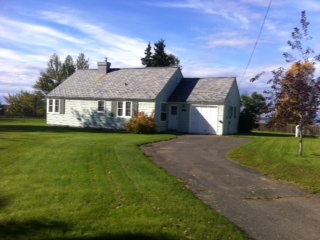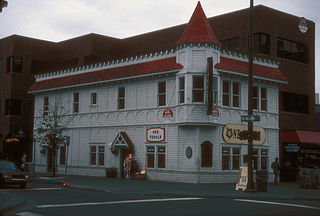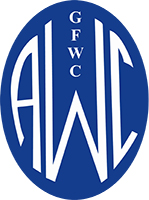
The Cape St. Elias Light is a lighthouse on Kayak Island in Alaska.

This is a list of the National Register of Historic Places listings in Anchorage, Alaska.

The Old Federal Building in Anchorage, Alaska is a structure serving primarily as a courthouse of the United States District Court for the District of Alaska. Completed in stages from 1939 to 1941, the building was listed in the National Register of Historic Places in 1978.

Anchorage Depot, also known as Alaska Railroad Depot, is the railroad station at the center of the Alaska Railroad system at the junction of the two main lines their trains run on. It serves as the starting point for many tourists traveling on the luxury trains such as the Denali Star. The station is a Moderne-style three story concrete building, built in 1942 and enlarged in 1948.

The Alaskan Engineering Commission (AEC) was a U.S. Federal agency, sometimes known by its initials or by alternate spelling Alaska Engineering Commission. It was created by the Alaska Railroad Act in 1914 by U.S. President Woodrow Wilson in order to arrange for the construction of a railway system in Alaska. William C. Edes was named chairman, chief engineer Colonel Frederick Mears. In 1915, the AEC became part of the U.S. Department of the Interior. In 1923, after the railroad began operation and construction was complete, it became the Alaska Railroad Commission, later renamed to The Alaska Railroad.

The Alaska Engineering Commission Cottage No. 25 is a historic house at 345 West Third Avenue in Anchorage, Alaska. It is a two-story wood-frame structure, with a low-pitch gable roof that has wide overhanging eaves with exposed rafter tails. It was designed and built in 1917 by the Alaska Engineering Commission, a Federal agency charged with building railways in Alaska. It is one of the second set of such housing built by the commission, and is now owned by Anchorage Historic Properties.

The Alaska Engineering Commission Cottage No. 23, also known as DeLong Cottage, is an historic house at 618 Christensen Drive in Anchorage, Alaska. It is a 1+1⁄2-story wood-frame structure, with a gable roof and porch extending across its front. It was designed and built in 1916 by the Alaska Engineering Commission (A.E.C.), the federal government project to build the Alaska Railroad. Of the surviving cottages built by the commission, it is the least-altered and best-preserved.
The Whitney Section House, also known as Whitney Station, is a historic railroad-related building in Wasilla, Alaska. It is a single-story wood-frame structure, which was built in 1917 by the Alaska Railroad. It originally stood at mile 119.1, about 4.8 miles (7.7 km) north of Anchorage Station, and was one of a series built by the railroad and located at roughly ten-mile intervals. The area where it stood was taken by the federal government for Elmendorf Air Force Base, and was rescued from demolition by the local chapter of the National Railroad Historical Society. It now stands on the grounds of the Alaska Museum of Transportation and Industry in Wasilla, and has seen a variety of uses.

The Anchorage Hotel is a hotel located at 330 E Street in Anchorage, Alaska, United States. The original Anchorage Hotel building was built in 1916; the current hotel building, which was constructed as an annex to the hotel, opened in 1936. C.B. Wark built the first hotel building; while the building was originally a wood-frame structure, Frank Reed upgraded the building to a luxury hotel in 1917. The hotel outgrew its original building due to Anchorage's growth in the 1930s, so the Anchorage Hotel Annex was built in 1936 to house additional guests. The annex, designed by E. Ellsworth Sedille, had a Gothic design and was one of the tallest buildings in Anchorage at the time. Guests at the hotel included Warren Harding, Harold L. Ickes, Walt Disney, Wiley Post, and Will Rogers; the latter two stayed at the hotel only two days prior to their deaths in a plane crash. In addition, artist Sidney Laurence lived in the hotel for parts of the 1920s and 1930s; Laurence once exchanged a painting of Mount McKinley for a year's rent at the hotel.

The Old Anchorage City Hall, also known as Historic City Hall, is located at 524 West Fourth Avenue in Anchorage, Alaska. It is a two-story cast concrete building, designed by E. Ellsworth Sedille and built in 1936 with funding from the Public Works Administration. It housed the city administration of the city until 1979, when most of the integrated city-borough administration was moved to the Hill Building at 632 West 6th Avenue.

The Civil Works Residential Dwellings, also known as the Brown's Point Cottages and Corps of Engineers Houses, are a pair of historic houses at 786 and 800 Delaney Street in Anchorage, Alaska. The two houses, mirror images of one another, are single-story wood-frame structures with wide clapboard siding, a metal gable roof, and an attached single-car garage. Built in 1941 to house officers of the United States Army Corps of Engineers, they are among the least-altered of Anchorage's World War II-era military facilities.

The Leopold David House is a historical building located at 605 West Second Avenue in Anchorage, Alaska. It is a 1+1⁄2-story bungalow-style house with a wooden frame structure. It features a front-gable roof and dormers. The front facade is divided into two sections: the left with a projecting bay section, and the right with a gabled porch. The roofs have deep eaves with Craftsman-style brackets. The house was built about 1917 for Leopold David (1878-1924), an early resident of Anchorage and its first mayor, elected in 1920. It is one of the best-preserved houses of the period in the city.

The Oscar Gill House is a historic house at 1344 West Tenth Avenue in the South Addition neighborhood of Anchorage, Alaska. It is one of Anchorage's oldest buildings. It is a two-story wood-frame structure, three bays wide, with a side gable roof. The bays are asymmetrically arranged, with a single-window bay on the right and a double-window bay on the left. The center bay is taken up by a projecting gable-roofed vestibule, in which the door is slightly off-center. The house's modest Craftsman style includes extended eaves with exposed rafter ends, and it has retained original interior flooring and woodwork. The house was built in 1913 by Oscar Gill in the town of Knik at the head of Knik Arm. When Anchorage was established in 1916, Gill had the house barged across the inlet, and it stood at 918 West Tenth Avenue for many decades. The house was removed from that site in 1982 to accommodate expansion of the Anchorage Pioneer Home, one of many historic houses throughout downtown Anchorage which fell victim to a real estate and building boom that intensified in 1982 and 1983. Unlike other similar structures, most of which spent years in storage on municipally-owned land but were eventually demolished, this house was spared. It sat on a vacant lot on P Street, across from the western end of the Delaney Park Strip, for approximately a decade and a half before being moved to its present location. The house has been operated as a bed and breakfast establishment since that time.

The Knik Site, also known as the Old Knik Townsite, is the location in Matanuska-Susitna Borough, Alaska that was once home to the largest settlement on Cook Inlet. The only surviving remnants of the community are a former log roadhouse, now a museum operated by the Wasilla-Knik Historical Society, and a log cabin. The Knik area had long been a meeting point of Native Alaskans, and in 1898 it became the principal community on Cook Inlet from which goods were shipped into the interior. In 1916 the Alaska Railroad reached the site of present-day Anchorage, bypassing Knik and leading to Anchorage's growth. When the railroad reached Wasilla, Knik lost all importance as a transshipment point, and its buildings were either abandoned or moved to one of the other communities. Knik is located about 13 miles (21 km) southwest of Wasilla.

The Loussac–Sogn Building is a historic commercial building at 429 D Street in downtown Anchorage, Alaska. It is a three-story Moderne-style building, with storefronts on the ground floor and offices above, with its long side extending along 5th Avenue, and its main entrance, on D Street. The based on the building up to the storefront windows is finished in green tile, while most of the building is finished in concrete. The main entrance has a polished stone surround. Built in 1947, it is one of the oldest surviving Moderne structures in the city, and was the largest office building in the city at its completion. It was planned by Zachariah J. Loussac and Dr. Harold Sogn as a small building to house Dr. Sogn's medical practice, but grew in the design to its more substantial form.

The Potter Section House is a historic section house in Anchorage Borough, Alaska. It is located at Mile 115.3 of the Seward Highway and Mile 100.6 of the Alaska Railroad. It is a 1+1⁄2-story wood-frame structure with a gable roof. The main facade has a center entrance flanked by sash windows, while the rear facade also has an entrance but only a single window. Built in 1929 to a slight variation from a standard plan, it is the last of four section houses to survive on the Anchorage stretch of the railroad. The building was used as housing for workers on the surround section of railroad until section-based maintenance was discontinued in 1978. It currently hosts the Chugach State Park headquarters.

The Wendler Building is a historic commercial building at 400 D Street in Anchorage, Alaska. Built in 1915 by Tony and Florence Wendler, it is the oldest commercial building in the city. The building was listed on the National Register of Historic Places in 1988.

The Anchorage Woman’s Club (AWC) is a woman's club founded in 1915. It was instrumental in organizing the construction of the first schoolhouse in Anchorage.





















